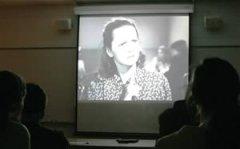Students find value in interim

Spending every day watching movies sounds like an amusing way to spend interim. But hold the popcorn, Milk Duds and Pepsi— the students taking this class were in it for much more than its entertainment value.
“I was interested in seeing the way that the media influences culture,” said Zig Ingraffia, a junior psychology major, who selected “Movies and Mental Illness” for his three-week interim course. “The public is not very well informed about mental illness, and the media can be very influential on the culture—or reflect the culture, depending.”
For senior Rachel Hasey, a nursing student who has spent some time with patients in the mental health section at Pine Rest Christian Hospital, it was about finding a connection with people who have a mental illness. “Most of the movies are such a distortion of what mental illness really is,” she said. “The impression that they give to people who are watching is that mental illness is a violent and scary thing. People assume from this that we can’t expect someone with a mental illness to be safe or rational.”
Certainly that is the case in many films, according to psychology professor Scott Stehouwer, who has taught the popular class six times. In fact, horror films and suspense thrillers, in which one of the central characters suffers from an emotional disorder or mental illness (think Silence of the Lambs or Psycho), are one of the main genres of film studied in the class.
Also studied, though, were docudramas (One Flew Over the Cuckoo’s Nest and Ordinary People) and comedies (What About Bob?).
“Interim is an opportunity to integrate a variety of different areas into one course,” said Stehouwer. “In this class we combine film studies, history and psychology. What I’m really trying to do is mimic life after graduation in which areas will overlap, and students are provided with skills to look at films with some critical thinking.”
The class began with a week-long historical look at how mental illness is portrayed in film, beginning with the 1919 silent film The Cabinet of Dr. Caligari. Students also view and compare The Snake Pit (1948), the classic One Flew Over the Cuckoo’s Nest (1975), What About Bob? (1991) and Good Will Hunting (1997).
“The historical basis gives students the chance to watch how things change over time,” said Stehouwer.
In a class discussion comparing The Cabinet of Dr. Caligari and The Snake Pit, students noted that while both portrayed mental illness inaccurately to some degree, in the 30-year span progress had been made toward emphasizing that there is “hope about psychological disorders. It’s not all despair.”
In the second week of class, students studied portrayals of distinct illnesses such as anxiety disorders (As Good as It Gets), dissociative personality disorder (Psycho, The Three Faces of Eve), mood disorders (Ordinary People) and psychosis (Taxi Driver).
The final week allowed student groups to present a film of their choosing and lead a class discussion.
“I’m always impressed with the quality of what the students bring in,” said Stehouwer. “I’m impressed with their critical thinking. They often will introduce me to films that I haven’t seen or considered for this class before."
For instance, last year one group of students presented and discussed the Joker character from The Dark Knight (2008). “It was a really interesting discussion about that character and what we portrayed in that film,” Stehouwer said.
Near the beginning of the class, senior Kristin Kurtz said she was hopeful she would build her knowledge about psychology and mental illness. A studio art major and psychology minor, Kurtz plans to work in art therapy. “I’m intrigued with how different the portrayals of mental illness are—horror, comedy, whatever,” she said. “The movies affect how the public think about mental illness, and I’m anxious to learn about that.”
The three-week-long interim session affords students the opportunity to focus on one class, within or outside of their major. Many offerings are also available off campus.






